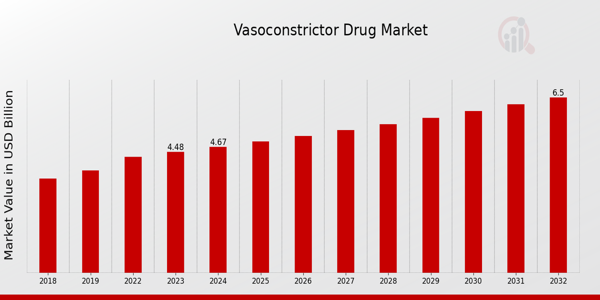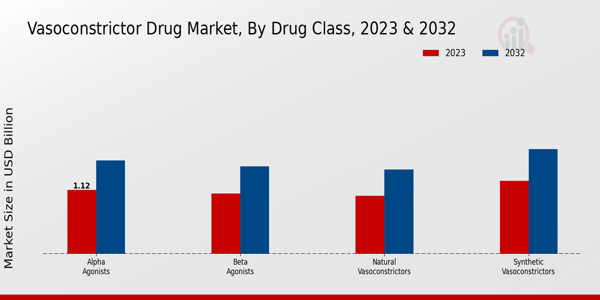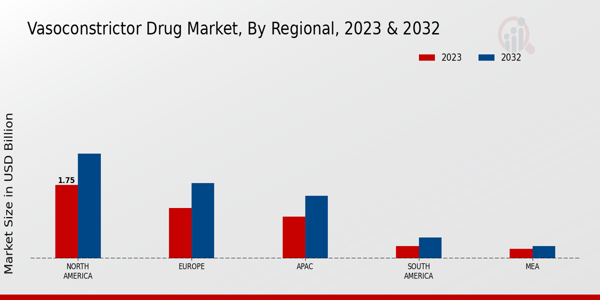Vasoconstrictor Drug Market Overview
As per MRFR analysis, the Vasoconstrictor Drug Market Size was estimated at 4.87 (USD Billion) in 2024. The Vasoconstrictor Drug Market Industry is expected to grow from 5.07 (USD Billion) in 2025 to 7.36 (USD Billion) till 2034, at a CAGR (growth rate) is expected to be around 4.22% during the forecast period (2025 - 2034).
Key Vasoconstrictor Drug Market Trends Highlighted
The Vasoconstrictor Drug Market is witnessing growth owing to rising incidences of conditions like low blood pressure and shock, which warrant treatment. Increasingly, more critical care units and emergency medical services also boosted the demand for such medicines. New drug development and the advancement of various drug delivery systems are currently improving the effectiveness and convenience of Vasoconstrictor use. With the growing awareness of the importance of hemodynamic stability in patients, the market, however, is anticipated to maintain steady growth. There are a number of opportunities available for the stakeholders of the vasoconstrictor drug market.
The future of drug development lies in minimizing harmful side effects while maximizing efficacy in drug formulation, which goes a long way in enhancing patient recovery after treatment. The combined use of vasoconstrictors and other agents as treatment options may advance the search for treatment even further. Additionally, the emergence of telemedicine and home healthcare opens doors for the treatment and management of vasoconstrictor therapies, thereby improving accessibility for patients who would otherwise be unable to receive such care. In particular, recently, the market has become known for its focus on individualized or personalized approaches to vasoconstrictor therapy.
This evolution is facilitated by progress in pharmacogenomics, which enables some healthcare professionals to anticipate how the patient will respond due to his heredity. Moreover, the patient-centric focus in contemporary healthcare systems is also motivating the efforts towards the R&D of vasoconstrictor drugs, and these will enhance the treatment forms available. The rising prevalence of awareness of cardiovascular diseases is also escalating the utilization of vasoconstrictor drugs, reiterating the requirement for further progress and change in the market.

Source: Primary Research, Secondary Research, MRFR Database and Analyst Review
Vasoconstrictor Drug Market Drivers
Increasing Incidence of Cardiovascular Disorders
The Vasoconstrictor Drug Market Industry is significantly driven by the rising prevalence of cardiovascular diseases worldwide. As lifestyles become increasingly sedentary and unhealthy dietary choices become more common, populations are experiencing a surge in conditions such as hypertension, heart failure, and other related disorders. Vasoconstrictor drugs play a crucial role in the management of these conditions, as they work by narrowing blood vessels to increase blood pressure.The growing awareness and focus on heart health have resulted in a heightened demand for these medications. Moreover, advancements in medical technology and pharmaceutical research are leading to the development of more effective vasoconstrictor drugs, encouraging healthcare providers to adopt these treatments for better patient outcomes. The aging population, which often suffers from multiple chronic conditions, also contributes to the expanding market for vasoconstrictor drugs, as older adults are more susceptible to cardiovascular issues.This demographic shift, alongside the increasing efforts of governments and health organizations to promote heart health awareness, is anticipated to create a favorable environment for the growth of the Vasoconstrictor Drug Market Industry in the coming years.
Rapid Advancements in Pharmaceutical Research
The Vasoconstrictor Drug Market Industry is propelled by rapid advancements in pharmaceutical research and development practices. New drug discoveries and innovations in formulation technologies lead to more potent and targeted vasoconstrictor agents. Ongoing research is not only enhancing the efficacy and safety profiles of these drugs but also exploring their applications in various therapeutic areas, thereby broadening their potential market.This trend of innovation helps in addressing unmet medical needs and positions companies to capture a larger share of the market.
Growing Awareness of Emergency Medical Services
Another significant driver for the Vasoconstrictor Drug Market Industry is the growing awareness and improvement in emergency medical services. As the healthcare sector evolves, there is a greater emphasis on rapid response and effective treatment of acute cardiovascular incidents. Vasoconstrictors are often pivotal during emergency situations to stabilize patients, especially in cases of shock and severe hypotension. The increased training of emergency responders and the widespread availability of these drugs in clinical settings ensure that patients receive timely intervention, further fuelling the demand for vasoconstrictor medications.
Vasoconstrictor Drug Market Segment Insights
Vasoconstrictor Drug Market Drug Class Insights
The Vasoconstrictor Drug Market is witnessing a steady increase in value, particularly within the Drug Class segment, which encompasses Alpha Agonists, Beta Agonists, Natural Vasoconstrictors, and Synthetic Vasoconstrictors. The market was valued at 4.48 USD Billion in 2023, reflecting the growing demand for vasoconstriction therapies across various medical applications, including anesthetic procedures and treatment of hypotension. The segmentation highlights that Alpha Agonists take a leading role, valued at 1.12 USD Billion in 2023 and expected to rise to 1.64 USD Billion by 2032, which showcases their importance in the market due to their significant application in managing blood pressure and effectively treating shock. In contrast, Beta Agonists, with a valuation of 1.06 USD Billion in 2023, play a crucial role in respiratory treatments but remain slightly less dominant than Alpha Agonists; however, their relevance cannot be understated, particularly in managing asthma and chronic obstructive pulmonary disease (COPD). The Natural Vasoconstrictors segment, valued at 1.02 USD Billion in 2023, provides alternative treatment options that align with the growing trend toward natural and holistic therapies, thus driving innovation and interest in this area. This segment is anticipated to gain traction as more healthcare providers and patients seek out less synthetic and more natural treatment pathways despite its currently smaller market share. Finally, Synthetic Vasoconstrictors command a valuation of 1.28 USD Billion in 2023, marking them as a significant player in the overall market; their robust efficacy in acute care settings contributes to their strong presence. The steady growth across all these categories indicates that while Alpha Agonists hold a majority due to their widespread clinical utility, the continuous innovations and varying patient needs create substantial opportunities for all segments within the Vasoconstrictor Drug Market, supported by the overarching trend toward diverse treatment options.

Source: Primary Research, Secondary Research, MRFR Database and Analyst Review
Vasoconstrictor Drug Market Administration Route Insights
The Vasoconstrictor Drug Market is witnessing steady growth, particularly in the Administration Route segment, which plays a crucial role in the effective delivery of these medications. In 2023, the market was valued at 4.48 billion USD, reflecting the increasing demand for vasoconstrictors across various clinical settings. The Administration Route division encompasses multiple methods, including Intravenous, Intramuscular, Subcutaneous, and Oral administrations. Among these, Intravenous delivery is significant due to its rapid onset of action, making it a preferred choice in emergency care situations where time is of the essence.Intramuscular and Subcutaneous routes have their own advantages, particularly regarding ease of use and patient compliance, contributing to their steady demand. Oral administration, while generally slower in effect, presents a convenient option for outpatient management, further diversifying the usage scenarios. Insights from the Vasoconstrictor Drug Market data highlight trends such as a growing inclination toward minimally invasive administration methods, along with responsive healthcare systems that are adapting to the specific needs of patients.Current trends also underline the importance of innovation in formulation to enhance the efficiency of delivery mechanisms, ultimately driving market growth and opportunities for new entrants in the industry.
Vasoconstrictor Drug Market Therapeutic Application Insights
The Vasoconstrictor Drug Market, valued at 4.48 billion USD in 2023, encompasses a variety of therapeutic applications that are crucial for managing critical health conditions. Among these applications, hypotension treatment stands out, providing essential support in ICU settings where maintaining blood pressure is vital for patient stability. Nasal decongestion is also significant, utilized widely in respiratory treatments to alleviate symptoms associated with various ailments such as colds and allergies. Cardiac arrest management plays a pivotal role in emergency medicine, with the rapid administration of vasoconstrictors being key to improving outcomes during resuscitation efforts.Additionally, surgical procedures benefit greatly from vasoconstrictor applications, as they help minimize blood loss and enhance surgical visibility. This diverse segmentation within the Vasoconstrictor Drug Market highlights the essential role these drugs play across multiple healthcare areas, driving ongoing growth and innovation within the industry. The trends suggest an increasing demand for more targeted and effective delivery methods, as well as a focus on developing medication that optimally addresses each therapeutic need.
Vasoconstrictor Drug Market End User Insights
The Vasoconstrictor Drug Market focuses significantly on various End Users, notably including hospitals, clinics, and homecare settings. In 2023, the market was valued at 4.48 billion USD, reflecting a steady growth influenced by an increasing prevalence of cardiovascular diseases and the need for effective treatment options. Hospitals play a crucial role in this market segment, as they are primary centers for acute care where vasoconstrictor drugs are commonly administered during surgical procedures and emergency treatments. Clinics also contribute notably, providing outpatient services that cater to patients requiring these medications for various health conditions.Homecare settings are emerging as vital contributors to the market, driven by the growing trend of patient-centered care and the rise of telehealth services, which allow for ongoing treatment outside of traditional medical facilities. Overall, the End User segment showcases the importance of accessibility and flexibility in treatment approaches, significantly impacting the Vasoconstrictor Drug Market revenue and growth potential as healthcare paradigms continue to evolve.
Vasoconstrictor Drug Market Regional Insights
The Vasoconstrictor Drug Market revenue is projected to experience notable growth from 2023 to 2032, with regional segments showcasing varied performance levels. In 2023, North America leads with a valuation of 1.75 USD Billion, reflecting a significant majority holding in the market. Europe follows with 1.2 USD Billion, underscoring its substantial involvement in the Vasoconstrictor Drug Market. APAC's contribution stands at 1.0 USD Billion, demonstrating its importance due to a growing population and increasing healthcare investments.South America represents a smaller segment with a valuation of 0.3 USD Billion, yet its emerging market potential offers opportunities for expansion. Meanwhile, the MEA region, valued at 0.23 USD Billion, faces unique challenges but also presents potential for growth in the pharmaceutical industry. The research data indicates that these regions play critical roles in market development, driven by an increasing prevalence of conditions treated by vasoconstrictors and rising healthcare expenditure across global markets. New product developments and regulatory advancements are also expected to influence market dynamics positively across these regions.

Source: Primary Research, Secondary Research, MRFR Database and Analyst Review
Vasoconstrictor Drug Market Key Players and Competitive Insights:
The Vasoconstrictor Drug Market is a dynamic sector characterized by the increasing demand for medications that manage various medical conditions related to blood vessel constriction. Vasoconstrictors play a crucial role in treating hypotension, shock, and other cardiovascular issues, which has led to heightened competition among pharmaceutical companies. The market is influenced by factors such as technological advancements, regulatory changes, and evolving patient needs as clinicians seek effective treatments. Additionally, the rise of chronic diseases requiring long-term vasoconstrictor therapy adds complexity to the market landscape, pushing companies to innovate and differentiate their product offerings effectively. As the market evolves, understanding competitive positioning becomes essential for stakeholders looking to capitalize on new opportunities arising from changing healthcare dynamics.Sanofi has established a significant presence in the Vasoconstrictor Drug Market through its extensive portfolio of products targeting various cardiovascular conditions. The company's strong research and development capabilities enable it to develop innovative treatments that meet the evolving needs of patients and healthcare providers. Sanofi's global reach facilitates its ability to distribute its products widely, ensuring availability across diverse markets. Furthermore, the company's reputation for quality and efficacy helps it hold a competitive edge in the sector. Sanofi's strategic partnerships and collaborations within the healthcare ecosystem enhance its capacity to drive innovation and respond to market challenges effectively. The company's commitment to addressing unmet medical needs within the vasoconstrictor domain further solidifies its strengths in the market.Sandoz, a leader in the generic pharmaceuticals segment, plays an essential role in the Vasoconstrictor Drug Market by offering cost-effective alternatives to brand-name products. With a strong focus on quality and compliance, Sandoz leverages its expertise in manufacturing to ensure that its vasoconstrictor medications meet rigorous safety and efficacy standards demanded by regulatory authorities. The company's well-established distribution networks allow it to reach a wide array of healthcare facilities, thus enhancing access to its products. Sandoz's commitment to innovation includes investing in biosimilars and other advanced pharmaceuticals, which positions it effectively to address the growing demand for affordable treatment options among healthcare providers. The company’s robust pipeline of generic vasoconstrictor drugs reflects its strategic intent to capture a significant share of the market, benefiting both healthcare providers and patients. Through its proactive approach, Sandoz aims to solidify its reputation as a trustworthy provider in the competitive landscape of vasoconstrictor therapies.
Key Companies in the Vasoconstrictor Drug Market Include
Vasoconstrictor Drug Market Industry Developments
Recent developments in the Vasoconstrictor Drug Market have been significant, with companies like Sanofi, Merck, and AstraZeneca focusing on strengthening their product portfolios. Merck has seen an increased demand for their vasoconstrictor therapies, contributing positively to their market valuation. Meanwhile, Eli Lilly has been expanding its research and development efforts to capture a larger market share, particularly in novel vasoconstrictor formulations. Notably, Hikma Pharmaceuticals and Novartis have been involved in strategic collaborations aimed at enhancing distribution channels for their vasoconstrictor drugs. In terms of mergers and acquisitions, there have been discussions surrounding potential deals involving Teva Pharmaceuticals and AbbVie, emphasizing efforts to consolidate market presence and boost competitiveness within the vasoconstrictor segment. Growth in market valuation can be attributed to increased demand for therapeutic options in critical care settings, as well as advancements in clinical trials that indicate favorable outcomes for existing vasoconstrictor treatments. Cardinal Health's active distribution efforts have also contributed to optimizing supply chains within the sector, positively impacting overall market dynamics. The Vasoconstrictor Drug Market continues to evolve in response to patient needs and regulatory landscapes, showcasing a robust trajectory for growth.
Vasoconstrictor Drug Market Segmentation Insights
Vasoconstrictor Drug Market Drug Class Outlook
- Synthetic Vasoconstrictors
Vasoconstrictor Drug Market Administration Route Outlook
Vasoconstrictor Drug Market Therapeutic Application Outlook
- Cardiac Arrest Management
Vasoconstrictor Drug Market End User Outlook
Vasoconstrictor Drug Market Regional Outlook
| Report Attribute/Metric |
Details |
|
Market Size 2024
|
4.87 (USD Billion)
|
|
Market Size 2025
|
5.07 (USD Billion)
|
|
Market Size 2034
|
7.36 (USD Billion)
|
|
Compound Annual Growth Rate (CAGR)
|
4.22 % (2025 - 2034)
|
|
Report Coverage
|
Revenue Forecast, Competitive Landscape, Growth Factors, and Trends
|
|
Base Year
|
2024
|
|
Market Forecast Period
|
2025 - 2034
|
|
Historical Data
|
2020 - 2024
|
| Market Forecast Units |
USD Billion |
| Key Companies Profiled |
Sanofi, Sandoz, Merck, Eli Lilly, Hikma Pharmaceuticals, Novartis, AstraZeneca, Amgen, Cardinal Health, AbbVie, Teva Pharmaceuticals, Baxter International, Pfizer, GSK |
| Segments Covered |
Drug Class, Administration Route, Therapeutic Application, End User, Regional |
| Key Market Opportunities |
Growing demand for emergency care, Advancements in drug formulations, Expanding geriatric population, Increased prevalence of cardiovascular diseases, Rising use of anesthesia and surgeries |
| Key Market Dynamics |
Rising prevalence of cardiovascular diseases, Increasing geriatric population, Advancements in drug formulation, Growing surgical procedures demand, Regulatory support for drug approvals |
| Countries Covered |
North America, Europe, APAC, South America, MEA |
Frequently Asked Questions (FAQ) :
The Vasoconstrictor Drug Market is expected to be valued at 6.5 USD Billion in 2034.
The expected CAGR for the Vasoconstrictor Drug Market between 2025 to 2034 is 4.22%.
North America holds the largest market share with a value of 1.75 USD Billion in 2023, expected to grow to 2.5 USD Billion in 2034.
Key players in the market include Sanofi, Merck, Novartis, Pfizer, and AstraZeneca, among others.
The market size for Alpha Agonists is projected to reach 1.64 USD Billion in 2034.
The Beta Agonists segment is valued at 1.06 USD Billion in the year 2023.
Natural Vasoconstrictors are expected to be valued at 1.48 USD Billion in 2034.
The projected market value for Europe in 2032 is 1.8 USD Billion.
Emerging trends in chronic disease management and advancements in drug formulations present significant opportunities in the market.
Regulatory hurdles and high competition among key players might pose challenges to market growth.

















